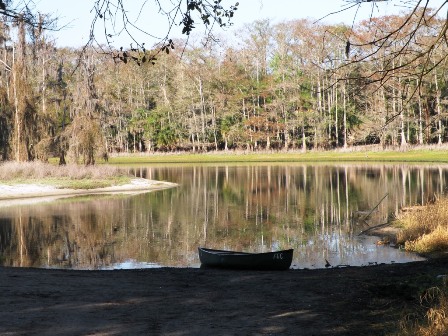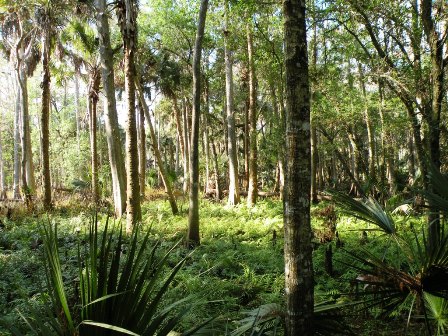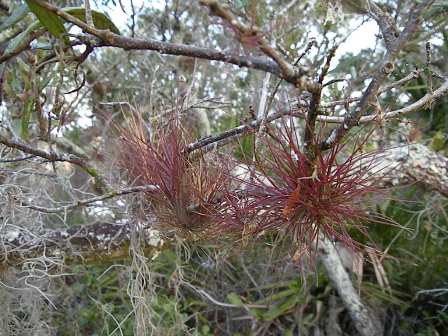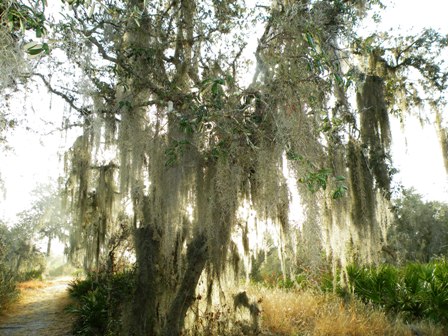|

Fisheating Creek,
Palmdale, Florida
Fisheating Creek Outpost
7555 US Hwy 27 N
Palmdale, FL 33944
863-675-5999
http://www.fisheatingcreekroutpost.com
This wonderful slice of old Florida
sits on the west side of Lake Okeechobee, in the tiny town of Palmdale.
If you’ve heard of Moore Haven, you might get your bearings if you think
about traveling another 10 miles or so west.
If you've ever been to the grocery
store and bought bologna or ham with the name Lykes on the package, you
already know a little bit about the history of this park. More on that a
little later....
Birding
The park is 18,000 acres of
native Florida land and is home to some of the most beautiful birds the
state has to offer. Here you'll find Ibis, Bald Eagles, Swallow-tail
Kites, Blue Heron, rare Wood Storks, Great White Heron, Cranes, Egrets
and Wild Turkeys.
Fishing
The creek itself is 52 miles
long and challenges fishermen to catch bass, crappie, catfish, brim,
armored catfish and tilapia.
Wildlife
In case alligators and
birds don't satisfy your quest for Florida's wildlife, look for
red-eared turtles, wild deer and boar wandering through the cypress
trees at Fisheating Creek. Even Florida Panther and Black Bear roam
freely about the park!
Camping
Both primitive (tents) and full hook-up RV
sites are available at the Palmdale campground area. For campers who
have forgotten night crawlers, toilet paper and pickled pigs feet, the
little country store in the camp office can provide all the necessities.
The cooler winter months and weekends are busiest, so make a reservation
early.
History
The creek starts up north in Highlands County
and runs through forests, pastures and marshes, and finally reaches Lake
Okeechobee. The first known settlers at Fisheating Creek, going back
between 1000 and 500 BC, used its resources as a canoe highway
leading to Lake Okeechobee. Around the 1500's, as the Spanish began to
arrive in Florida, a group of people known as the Guacata occupied this
area. These were the original descendents of the Belle Glade people. At
this time, the area was still in a natural state; unexplored and
undisturbed. It wasn't until the mid-1800's when enslavement,
disease, war and religious conversions started to create change. Native
Americans from central Georgia made their way to this area and
eventually replaced the original people. These people were short-lived;
they were removed during a series of Seminole wars from 1817 to 1858.
Now we get back to the Lykes Brothers. At the time, they were the
largest producer of cattle and the biggest meat packer in Florida. They
began buying up this land in the 1880's. The cowboys who worked the land
were known as "crackers," supposedly from the sound of their whips. The
last remaining Seminoles who lived at Fisheating Creek were forced to
leave around 1930, as cattle ranching and a sugar refinery at
Moore Haven were established. At first, all was well. The Lykes brothers
prevented development along the creek and kept it open to the people,
offering a campground and canoeing concession. However, in 1989, Lykes
closed the creek to the public and ignited a 10 year legal battle. The
litigation ended with the state of Florida purchasing 18,000+ acres and
creating the Wildlife Management Area.
Swimming
Just about the only thing staff will
DISCOURAGE you from doing is swimming in the creek. Even at low water,
you'll see alligators partially submerged in the water or sunning
themselves on the banks. For swimming, the staff suggests a cool
refreshing dip in Spring Lake, the spring-fed lake at the back of the
park. This is also a designated primitive camping area, with covered
pavillions and picnic tables.
So for a wonderful taste of the way things used to be,
pack the camper, the kids, the fishing rods and the canoe and visit
Fisheating Creek in Palmdale, Florida!
|

Looking NW from the primitive camping
area, here is a canoe waiting to be rented at Fisheating Creek.

Walking through the trails, this is the
hammock area you'll pass through, from the campground office to the
primitive camping sites.

There are 16 kinds of bromeliads that
grow in Florida. These plants are members of the pineapple family and
grow mostly attached to the tree's trunk and branches. They do not harm
the host tree. Most bromeliads collect water between their leaves and
may also serve as a habitat for small animals and/or a water source
during the dry months.

Live oak, often covered with moss, are the
predominant tree of the hammock portions of Fisheating Creek. You'll
also find tropical species like strangler figs and gumbo limbos, mixed
with cabbage palms.
|





